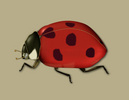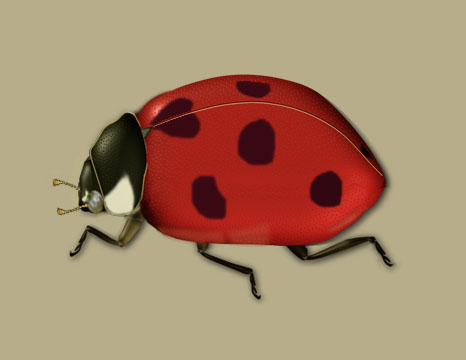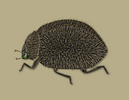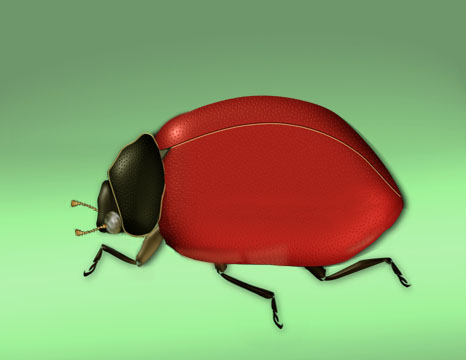You are here
Taxonomy
Coccinellidae
EOL Text
The Lost Ladybug Project: "Across North America ladybug species distribution is changing. Over the past twenty years several native ladybugs that were once very common have become extremely rare. During this same time ladybugs from other places have greatly increased both their numbers and range. Some ladybugs are simply found in new places. This is happening very quickly and we don’t know how, or why, or what impact it will have on ladybug diversity or the role that ladybugs play in keeping plant-feeding insect populations low. We're asking you to join us in finding out where all the ladybugs have gone so we can try to prevent more native species from becoming so rare."
| License | |
| Rights holder/Author | Katja Schulz, Katja Schulz |
| Source | No source database. |
Coccinellidae (Lady Beetles, Ladybirds, Lady Bugs)
Lady Beetles are small, round, with convex wing-covers. The head and pronotum are often shiny black with white markings, while the wing-covers are often shiny orange-red with black dots. Some species, however, are predominantly black, or gray with black dots, and may have fine hairs on their bodies. The adults usually feed on aphids, scale insects, and other small insects, while the larvae tend to feed on the same kinds of insects. Adults occasionally appear on flowers with exposed nectaries to feed on nectar. Lady Beetles are considered beneficial insects, although a few species feed on the foliage of crop plants.
- Hilty, J. Editor. 2014. Insect Visitors of Illinois Wildflowers. World Wide Web electronic publication. illinoiswildflowers.info, version (11/2014)
See: Abbreviations for Insect Activities, Abbreviations for Scientific Observers, References for behavioral observations
| License | http://creativecommons.org/licenses/by-nc/3.0/ |
| Rights holder/Author | Copyright © 2002-2014 by Dr. John Hilty |
| Source | http://www.illinoiswildflowers.info/flower_insects/files/beetles.htm |
Barcode of Life Data Systems (BOLD) Stats
Specimen Records:6961
Specimens with Sequences:6011
Specimens with Barcodes:5262
Species:373
Species With Barcodes:325
Public Records:2837
Public Species:164
Public BINs:189
| License | http://creativecommons.org/licenses/by-nc/3.0/ |
| Rights holder/Author | Adriano Giorgi, Natalia Vandenberg, Tree of Life web project |
| Source | http://tolweb.org/Coccinellidae/9170 |

Carl Linnaeus |

L. Redtenbacher |

M. E. Mulsant |
Present day members of the family Coccinellidae first appeared in Linnaeus’ (1758) Systema Naturae under the genus Coccinella, which contained, at the time, 36 species. Redtenbacher (1844) provided the first internal classification system for the family by recognizing two biologically defined groups, the plant feeders and the aphid feeders. His phytophagous group corresponds to the subfamily Epilachninae (sensu Sasaji 1968) but the aphidophagous one spans the other currently recognized subfamilies. Mulsant’s (1846; 1850) interpretation of the family diversity divided Coccinellidae into the “Trichoisomides” (the hairy species) and the “Gymnosomides” (the glabrous ones), a system that was even more artificial than its predecessor. Mulsant, however, was the first author to recognize supra-generic categories for the family many of which correspond to the current tribes in Coccinellidae. Korschefsky’s (1931) classification recognized the subfamilies Epilachninae, Coccinellinae, and Lithophilinae. This system is consistent with that of Redtenbacher but further subdivides the entomophagous taxa (the so-called “aphidophaga”) on the basis of the tarsal structure. Despite these advances, the classification of Coccinellidae was still rudimentary and extremely artificial until the second half of the 20th century.
In the most influential series of works of the 20th century dealing with this topic, Sasaji (1968; 1971a, b) revised the classification of the family, proposing six subfamilies: Sticholotidinae, Coccidulinae, Scymninae, Chilocorinae, Coccinellinae and Epilachninae. This system was widely accepted and remains the primary reference for the family (e.g., Booth et al., 1990; Pakaluk et al., 1994; Lawrence and Newton, 1995; Kuznetsov, 1997). Additional subfamilies have since been recognized: Azyiinae and Exoplectrinae, elevated from tribal status (Gordon, 1994); Ortaliinae, for Ortaliini plus Noviini (Kovář, 1996); and Hyperaspidinae, for Hyperaspidini plus Brachiacanthini (Duverger 1989; 2001) (Giorgi et al. 2009). In the most recent major contribution to the systematics of Coccinellidae, Kovář (1996) proposed a classification of Coccinellidae worldwide, recognizing seven subfamilies and 38 tribes. Duverger (2003) attempted to apply a distinct subfamily name to each of the 18 major groupings in Kovář 's dendrogram (1996). Many of these names, however, were invalid (based on junior synonyms), misspelled, or applied inconsistently within the different sections of the same paper.
Pope (1989) and Vandenberg (2002) pointed out major caveats in the current classification of Coccinellidae, emphasizing the lack of morphological support for most of the recognized subfamilies. Ślipiński (2007) acknowledged the criticism and proposed a more conservative system, in which only two subfamilies are recognized, Microweiseinae (=Scotoscymninae Duverger =Sticholotidinae sensu Kovář 1996, in part), and Coccinellinae. None of these various classifications has received a universal following (see Table below for alternative classifications).
Many regional taxonomic monographs have been published in the last three decades, including: Fürsch (1967) [European fauna]; Gordon (1985) [North America]; Hoang (1982; 1983) [Vietnam]; Iablokoff-Khnzorian (1982) [Palearctic and Oriental regions]; Kuznetsov (1997) [Russian Far East]; Pang and Mao (1979) [China]; Pope (1989) [Australian Coccinellinae]; Sasaji (1971a) [Japan]; and Savoiskaya (1983) [Central Asia and parts of the former USSR].
Table 1: Comparison of high-level classification systems of Sasaji (1971a), Kovář (1996) and Ślipiński (2007)
|
|
||
| Sasaji (1971a) | Kovář (1996) | Ślipiński (2007) (Australian taxa only) |
|---|---|---|
|
|
||
|
|
|
| Coccinellinae | ||
|
|
|
|
|
|
|
|
|
|
|
|
|
|
|
|
||
|
|
|
|
|
|
|
|
|
|
|
|
- 1Includes Oryssomini
- 2Includes Exoplectrini, Scymnini, Stethorini, and taxa near Shirozuellini and Azyiini
- 3Includes Halyziini
| License | http://creativecommons.org/licenses/by-nc/3.0/ |
| Rights holder/Author | Adriano Giorgi, Natalia Vandenberg, Tree of Life web project |
| Source | http://tolweb.org/Coccinellidae/9170 |
No Lady Beetles species are legally protected, and most are abundant and don't need special conservation. However, some native species have been disappearing at the same time that species from othe continents have arrived or been released. The invaders may be pushing the natives out.
| License | http://creativecommons.org/licenses/by-nc-sa/3.0/ |
| Rights holder/Author | ©1995-2012, The Regents of the University of Michigan and its licensors |
| Source | http://www.biokids.umich.edu/critters/Coccinellidae/ |
Lady beetles come in many different colors and patterns. Mouse over the following words to see more examples below: striped, checkered, banded, ocellate, metallic, punctuation marks, inkblot, radial lines.
The charismatic red and black dappled members of the tribe Coccinellini are easily recognized by the layperson, but the family as a whole is somewhat difficult to characterize. Most species can be identified by the broadly rounded to elongate body form with convex dorsum and flattened venter, clubbed antennae, and the presence of a postcoxal line on the first abdominal ventrite (lacking in Paranaemia, Naemia, and Coleomegilla). The tarsal formula of most species is 4-4-4 with the third tarsomere minute and tucked within the broad triangular second (cryptotetramerous or pseudotrimerous), only a few have the tarsomeres more equal (truly tetramerous), and some have tarsi reduced to 3-3-3 (truly trimerous).
It can be difficult to recognize a lady beetle without studying some of its minute morphological features. The majority of species are very small, drab, and pubescent ("furry") like the image below.
|
Explore some of the common body types found within the family Coccinellidae by mousing over the numbered legend below. What advantages do these different forms possess? What are their respective vulnerabilities?
More elongate <----1--- -----2----- -----3----- -----4----- ---5----> More compact |
Coccinellids are quite similar to endomychid beetles, but lack a frontoclypeal suture and have the mandibular mola reduced or absent. They also lack the impressed lines on the base of the pronotum which are characteristic of many endomychids.
The family Corylophidae also shares many affinities with Coccinellidae, but Corylophids posess a functional spiracle on abdominal segment 7 (lacking in Coccinellidae), have the galea and lacinia of the mouthparts fused into a single lobe (separate structures in Coccinellidae), and have a distinct form to the male genitalia.
| License | http://creativecommons.org/licenses/by-nc/3.0/ |
| Rights holder/Author | Adriano Giorgi, Natalia Vandenberg, Tree of Life web project |
| Source | http://tolweb.org/Coccinellidae/9170 |
A very few Lady Beetles eat plants we grow for food. Also, Lady Beetles sometimes accidentally hibernate in people's houses or other buildings. A few Lady Beetles may bite, but mainly by accident (you have some chemical on you that tastes good) or to defend themselves. The bite is not dangerous and doesn't hurt much.
Negative Impacts: injures humans (bites or stings); crop pest; household pest
| License | http://creativecommons.org/licenses/by-nc-sa/3.0/ |
| Rights holder/Author | ©1995-2012, The Regents of the University of Michigan and its licensors |
| Source | http://www.biokids.umich.edu/critters/Coccinellidae/ |
Lady Beetles are found all around the world. There are hundreds of species of lady beetles in North America. Also over a hundred species have been transported between continents by people hoping they would eat aphids and other pests better than the native beetles do.
Biogeographic Regions: nearctic (Introduced , Native ); palearctic (Introduced , Native ); oriental (Native ); ethiopian (Native ); neotropical (Native ); australian (Native )
| License | http://creativecommons.org/licenses/by-nc-sa/3.0/ |
| Rights holder/Author | ©1995-2012, The Regents of the University of Michigan and its licensors |
| Source | http://www.biokids.umich.edu/critters/Coccinellidae/ |












